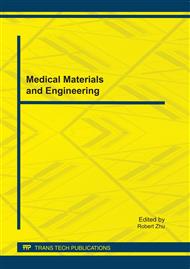[1]
Hall, M. J., Owing, M.F.. 2000 National Hospital Discharge Survery. National Center for Health Statistics: Hyattsville, MD, 2000,Vol 329.
Google Scholar
[2]
Greenwald, A. S., Garino J.P.. Bearing Surfaces: The Good, the Bad and the Ugly. J Bone Joint Surg. Am. 2001, 83-A, Supplement 2, Part2. 98-100.
DOI: 10.2106/00004623-200100022-00002
Google Scholar
[3]
Boyde A., Corsi A., Quarto R., Cancedda R., Bianco P.. Osteoconduction in Large Macroporous Hydroxyapatite Ceramic Implants: Evidence for a Complementary Integration and Disintegration Mechanism. Bone, 1999, 24:579-589.
DOI: 10.1016/s8756-3282(99)00083-6
Google Scholar
[4]
Mahendra A., Maclean A.D.. Available Biological Treatments for Complex Non-Unions. Injury, 2007, 38: 4-11.
DOI: 10.1016/s0020-1383(08)70004-4
Google Scholar
[5]
Arrington, E.D., Smith W.J., Chambers, H.G., et al. Complications of Iliac Crest Bone Harvesting. Clin. Orthop, 1996, 329: 300-309.
DOI: 10.1097/00003086-199608000-00037
Google Scholar
[6]
Banwart, J. C., Asher M. A., Hassanein R. S.. Iliac Crest Bone Graft Harvest Donor Site Morbidity. Astatistical Evaluation. Spine., 1995, 20: 1055-1060.
DOI: 10.1097/00007632-199505000-00012
Google Scholar
[7]
Yonger, E.M., Chapman, M.W.. Morbidity at Bone Graft Donor Sites. J. Orthop Trauma.,1989, 3: 192-195.
Google Scholar
[8]
Bohner M.. Resorbable Biomaterials as Bone Graft Substitutes. Materialstoday, 2010, 13:24-30.
DOI: 10.1016/s1369-7021(10)70014-6
Google Scholar
[9]
Heini, P.F., Berlemann, U.. Bone substitutes in Vertebroplasty. Eur Spine J.,2001,10:205-213.
Google Scholar
[10]
Vaccaro, A. R., Madigan, L..Spinal applications of biabsorbale implants. Orthopedics, 2002, 25: 1115-1120.
Google Scholar
[11]
Thomson, R. C., Yaszemski, M. J., Powers, J. M., et al. Hydroxyapatite fiber reinforced poly (alpha-hydroxy ester) foams for bone regeneration. Biomaterials, 1998, 19: 1935-1943.
DOI: 10.1016/s0142-9612(98)00097-0
Google Scholar
[12]
Marra, K. G., Szem, J. W., Kumta, P. N., et al. In Vitro Analaysis of Biodegradable Polymer Blend/Hydroxyapatite Composites for Bone Tissue Engineering. J. Biomed. Mater. Res., 1999, 47: 324-335.
DOI: 10.1002/(sici)1097-4636(19991205)47:3<324::aid-jbm6>3.0.co;2-y
Google Scholar
[13]
Ma, P, X., Zhang, R. Y., Xiao, G. Z., et al. Engineering new BONE TISSUE IN vitro on hightly porous poly(α-hydroxyl acids)/hydroxyapatite composite scaffolds. J. Biomed. Mater. Res., 2001,54: 284-293.
DOI: 10.1002/1097-4636(200102)54:2<284::aid-jbm16>3.0.co;2-w
Google Scholar
[14]
Hillsley, M. V., Frangos, J. A..The Role of Interstitial Fluid flow. Biotechnol. Bioeng.1994, 43:573-581.
Google Scholar
[15]
Weiner, S., Wagner, H. D.. The material bone: structure mechanical function relations. Annu. Rev. Mater. Sci., 1998, 28:271-298.
DOI: 10.1146/annurev.matsci.28.1.271
Google Scholar
[16]
Khairoun I, Driessens FC, Boltong MG, et al. Addition of cohesion promotors to calcium phosphate cements. Biomaterials. 1999, 20(4): 393-398.
DOI: 10.1016/s0142-9612(98)00202-6
Google Scholar
[17]
Driessens FCM, Boltong MG, Bermudez O, et al. Formulation and setting times of some calcium orthophosphate cements: a plot study.J. Mater. Sci. Mater. Med. 1993, 4:503-508.
DOI: 10.1007/bf00120130
Google Scholar
[18]
Munch E., Launey M. E., Alsem D. H., et al. Tough Bio-Inspired Hybrid Materials. Science, 2008, 322: 1516-1520.
DOI: 10.1126/science.1164865
Google Scholar
[19]
Feed C.E, Vunjak-novakovic G., Iron K.J.. Biodegradable Polymer Scaffolds for Tissue Engineering. Biotechnology,1994, 12: 689-695.
Google Scholar
[20]
Rzeszutek K. F., Sarraf J.E.. Proton Pump Inhibitors Control Osteoclastic Resorption of Calcium Phosphate Implants and Stimulate Increased Local Reparative Bone Growth. J. Craniofac. Surge., 2003 ,14: 301-307.
DOI: 10.1097/00001665-200305000-00007
Google Scholar
[21]
De'an Yang, Zi Yanga, Xu Lia et al. A study of hydroxyapatite/calcium sulphate bioceramics. Ceramics International. 2005, 31:1021–1023.
DOI: 10.1016/j.ceramint.2004.10.016
Google Scholar
[22]
Prokop A, Hofl A, Hellmich M, et al. Degradation of poly-L/DLlactide versus TCP composite pins: a three-year animal study. J Biomed Mater Res . 2005, 75: 304–310.
DOI: 10.1002/jbm.b.30300
Google Scholar
[23]
Zhang, M., Wang, J.S., Wei, X. C., et al. Performance Analysis of Injectable Dydroxyapatite/Calcium Sulfate Bone Substitute of Different Prescriptions. Chinese journal of clinical rehabilitation. 2006, 10: 69-71.
Google Scholar
[24]
Lee RW, Volz RG, Sheridan D. The role of fixation and bone quality on the mechanical stability of tibial knee components. Clin Orthop Rel Res. 1991, 273: 177-83.
DOI: 10.1097/00003086-199112000-00027
Google Scholar


